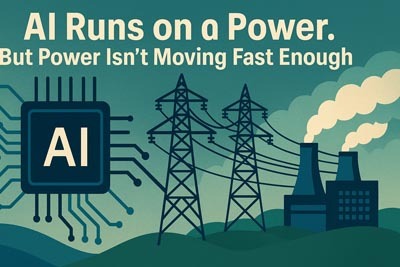
-
347 Views 0 Comments 0 Likes

DLNews Technology:
By Christian Bonilla
Artificial intelligence is booming — and America's power grid is struggling to keep up.
At the World Economic Forum, President Trump recently warned that 'We need double the energy we currently have in the United States for AI to be as big as we want to have it.' Elon Musk has echoed similar concerns, predicting that AI data centers could overwhelm the electricity supply next year. The Department of Energy predicts that AI-driven electricity demand could increase sixfold by 2030.
They're right about the scale of AI's electricity needs. But they're wrong about the diagnosis.
America doesn't suffer from a lack of energy resources. We have vast oil and gas reserves, plus growing solar and wind energy capacity. The real problem is getting the electricity that's already, or soon could be, generated from these energy sources to the data centers where it's needed.
Solving this coordination challenge will require a new approach to energy infrastructure — one with an eye toward future needs.
This distinction between coordination and total capacity matters. If the problem were simply about generating more electricity overall, the solution would be straightforward: build more power plants and transmission lines to bring power to all the new data centers. But that would — and will — take years, if not decades. New transmission lines alone often take years to complete.
Instead, we need to build new data centers next to existing energy deposits — such as natural gas fields in places like West Texas, Oklahoma, North Dakota, and elsewhere — so that power-hungry data centers can build on-site generating plants and obtain the electricity they need, without having to connect to the broader grid. Using standardized data-center designs and prefabricated components could further accelerate construction timelines and get data centers up and running years faster than previous generations of data centers built in traditional hubs like Northern Virginia or Silicon Valley.
Data center developers already recognize the advantages of this coordinated approach. A recent KPMG survey revealed that 77 % of data-center stakeholders consider it key to build alongside energy generation.
But in practice, data-center developers often struggle to understand and vet energy producers. And in turn, those producers often misunderstand the needs of data-center operators.
This is a challenge even for the largest AI developers. The Stargate project, a $500 billion AI data-center investment backed by OpenAI and SoftBank, chose Abilene, Texas, as its flagship site after fielding interest from sixteen different states — largely for Abilene’s energy availability, alongside other land and regulatory advantages. Despite the initial fanfare, practical challenges quickly tempered aspirations, and the initiative has mostly stalled. As a result, Stargate has quietly scaled back its 2025 ambitions to building a single data center — in Ohio.
To lead in the AI age, America will need more than chips and capital. It needs clearer rules, faster transactions between energy producers and AI developers, and a system that rewards coordination just as much as production.
If we solve this coordination challenge, America can lead the AI revolution and improve everything from health care to education to national security. But if we fail, we'll be left with plenty of power — just not where it matters.
Christian Bonilla is the Co-Founder and Co-CEO of DMARK Energy Solutions.
DLNews Editorial
Fact-Check Appendix (October 2025)
Trump’s “double the energy” quote
True (accurate quotation). Trump did say this at the 2025 World Economic Forum in Davos. However, experts note that doubling all U.S. electricity generation for AI is unrealistic; DOE and IEA projections suggest a 2–3× increase by 2030.
Elon Musk “predicting AI will overwhelm supply next year”
Unverified. No reliable, dated 2025 statement from Musk matches this exact claim, though he has discussed power constraints generally.
DOE predicting a sixfold AI electricity increase by 2030
Incorrect attribution. DOE has not published a 'sixfold' projection; EPRI and IEA analyses suggest 2–4× growth by 2030.
America doesn’t suffer from a lack of energy resources
Broadly true. The U.S. has ample fuel and renewable resources; main issues are transmission bottlenecks, permitting delays, and infrastructure coordination.
New transmission lines often take years to complete
Accurate. Transmission projects can take 5–10 years due to complex permitting and right-of-way issues.
Co-locating data centers with energy deposits
Partially valid. Behind-the-meter generation is emerging but presents reliability, regulatory, and emissions challenges.
KPMG survey: '77% of stakeholders favor co-location'
Unconfirmed. No public KPMG report shows this specific figure, though related surveys discuss energy proximity and sustainability concerns.
Stargate project — $500 billion investment by OpenAI and SoftBank
Unsupported. The Stargate venture exists but lacks verifiable data on scale or current status; claims of $500 billion or scaling back to Ohio remain speculative.
Overall diagnosis — grid coordination vs capacity
Directionally right. Coordination and infrastructure deployment are bottlenecks, but the article simplifies other issues like regulation, efficiency, and financing.
Verdict: Christian Bonilla’s essay identifies a real coordination problem between AI and energy sectors, but includes overstated or unsupported numerical claims. Its overall insight is that grid logistics matter as much as total capacity.

At Desert Local News, connections are everything. We're not just another social networking platform—we're a lively hub where people from all walks of life come together to share stories, spark ideas, and grow together. Here, creativity flourishes, communities grow stronger, and conversations spark global awareness.